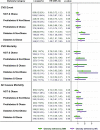Impact of diabesity phenotype on cardiovascular diseases, major cardiovascular events and all-cause mortality
- PMID: 37438573
- PMCID: PMC10338480
- DOI: 10.1038/s41598-023-38221-7
Impact of diabesity phenotype on cardiovascular diseases, major cardiovascular events and all-cause mortality
Abstract
To investigate the longitudinal association of different phenotypes of diabetes and obesity with the incidence of cardiovascular disease (CVD), CVD- and all-cause mortality. A total of 5432 adults, aged ≥ 35 years and free of CVD were included in this cohort study. Diabesity phenotypes were defined in six categories based on the presence of diabetes (normal (NG), prediabetes and diabetes) and obesity (obese, non-obese). Fasting blood sugar, 2-h post prandial glucose, or using anti-diabetic medicines were used to define diabetes, and body mass index and waist circumference were used to define obesity. Cox proportional hazards models were used to estimate hazard ratios (HRs) for incident CVD, CVD- and all-cause mortality across these categories. After a median follow-up of 11.25 years, 819 CVD cases, 181 CVD deaths and 488 all-cause deaths occurred. In multivariable-adjusted models and irrespective of obesity definition, the phenotypes of normal glucose-obese, prediabetes-obese and pre-diabetes-non obese were not associated with CVD incidence in comparison with NG-non obese phenotype, however, the phenotypes of diabesity, either defined by general or abdominal obesity, were associated with increased risk of incident CVD events (HR = 1.42, 95% CI 1.01, 1.99, and HR = 1.46, 95% CI 1.07, 1.98, respectively). These findings were sex-specific and only in men with a phenotype of abdominal obesity-diabetes, a positive link was observed for CVD incidence (HR = 1.60, 95% CI 1.01, 2.52). No significant association was found between diabesity and death from CVD or all causes. Diabesity is a predictor of CVD and stroke incidence, but not CVD or all-cause mortality, among Iranians. This association is more pronounced amongst men than women.
© 2023. The Author(s).
Conflict of interest statement
The authors declare no competing interests.
Figures




Similar articles
-
Diabesity phenotype and the risks of cardiovascular disease and subclinical atherosclerosis: A prospective cohort study.Obesity (Silver Spring). 2022 Aug;30(8):1681-1690. doi: 10.1002/oby.23465. Epub 2022 Jul 18. Obesity (Silver Spring). 2022. PMID: 35851578
-
Associations of diabesity with all-cause and cardiovascular disease mortality: Findings from the Mexico City Prospective Study.Diabetes Obes Metab. 2024 Jun;26(6):2199-2208. doi: 10.1111/dom.15528. Epub 2024 Mar 5. Diabetes Obes Metab. 2024. PMID: 38439662
-
Obesity measures, metabolic health and their association with 15-year all-cause and cardiovascular mortality in the SAMINOR 1 Survey: a population-based cohort study.BMC Cardiovasc Disord. 2021 Oct 21;21(1):510. doi: 10.1186/s12872-021-02288-9. BMC Cardiovasc Disord. 2021. PMID: 34674643 Free PMC article.
-
Different obesity phenotypes, and incident cardiovascular disease and mortality events in elderly Iranians: Tehran lipid and glucose study.Geriatr Gerontol Int. 2015 Apr;15(4):449-56. doi: 10.1111/ggi.12295. Epub 2014 Apr 21. Geriatr Gerontol Int. 2015. PMID: 24750352
-
Diabetes and obesity: the role of stress in the development of cancer.Endocrine. 2024 Oct;86(1):48-57. doi: 10.1007/s12020-024-03886-1. Epub 2024 Jun 3. Endocrine. 2024. PMID: 38831236 Free PMC article. Review.
Cited by
-
Independent relationship between sleep apnea-specific hypoxic burden and glucolipid metabolism disorder: a cross-sectional study.Respir Res. 2024 May 18;25(1):214. doi: 10.1186/s12931-024-02846-7. Respir Res. 2024. PMID: 38762509 Free PMC article.
-
Associations between dietary microbe intake and mortality risk in individuals with sleep disorders: Evidence from NHANES.PLoS One. 2025 Jun 25;20(6):e0326663. doi: 10.1371/journal.pone.0326663. eCollection 2025. PLoS One. 2025. PMID: 40561124 Free PMC article.
-
The dual challenge of diabesity: pathophysiology, management, and future directions.Naunyn Schmiedebergs Arch Pharmacol. 2025 May;398(5):4891-4912. doi: 10.1007/s00210-024-03713-4. Epub 2024 Dec 16. Naunyn Schmiedebergs Arch Pharmacol. 2025. PMID: 39680103 Review.
References
-
- World Health Organization. Obesity and overweight. Updated June 9, 2021. https://www.who.int/news-room/fact-sheets/detail/obesity-and-overweight. Accessed 7 December 2021.
Publication types
MeSH terms
Substances
LinkOut - more resources
Full Text Sources
Medical

